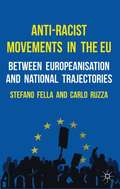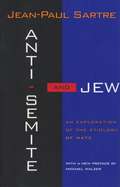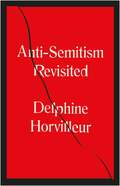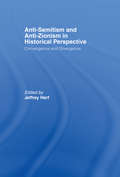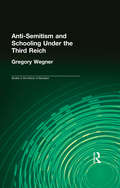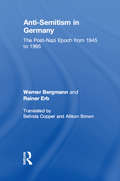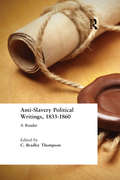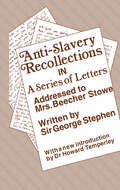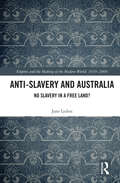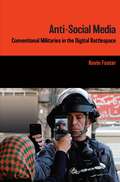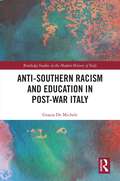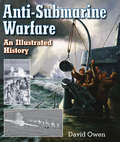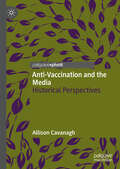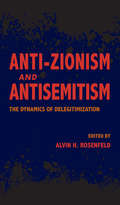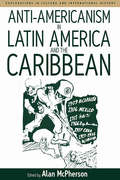- Table View
- List View
Anti-Racist Movements in the EU
by Stefano Fella Carlo RuzzaSuccessive EU treaties may have instituted a common framework for fighting racial discrimination and intolerance across Europe, but it is a framework that masks the significant differences that arise as a result of national context: for example, pre-existing national anti-racist policies and legislation; the degree of success, character and development of anti-racist movements as well as the political, socio-economic and cultural context in which these policies and movements arise. The aim of this book is to provide an understanding of these different national contexts by exploring the nature of anti-racist movements in six different EU member states and their relationship to political institutions and policy-making, while also reflecting on the impact of the new European sphere of decision-making. Drawing on extensive primary research involving interviews with movement and policy actors at the national and EU level, the book sheds light on the nature of racism and responses to it across Europe, analysing the impact of Europeanisation of policy-making on the sector, and exploring north-south and east-west differences and patterns of convergence.
Anti-Semite and Jew: An Exploration of the Etiology of Hate
by Jean-Paul Sartre George BeckerA classic study from the author of philosophy which is a must-read for any serious student of the aetiology of hatred.
Anti-Semitic Stereotypes without Jews: Images of the Jews in England 1290-1700
by Bernard GlassmanAnti-Semitic Stereotypes Without Jews offers an exploration of English history, 1290- 1700, tracing the growth and development of these attitudes. It demonstrates that it is possible for prejudice to thrive even in the absence of a scapegoat group. Following the expulsion in the year 1290 until 1656, although there was no real Jewish community in England, the molders of public opinion kept a shadowy image of the Jew alive through sermons and religious tracts, travelogues, folklore, religious and secular drama. In his analysis, Dr. Glassman shows that despite their theological differences, Anglican, Puritan, and Catholic clergymen concurred in the negative images of Jews presented to their congregations. They pictured the Jews as Christ-killers, and related myths of how Jews performed barbaric and sacrilegious rituals. The image was to plague Anglo-Jewry after a small community was reestablished in the second half of the 17th century. The author's belief that anti-Semitism is primarily a Christian problem transcends both time and place is covered by this volume. Anti-Semitic sentiments are seen here as reflecting deep-seated, irrational responses to the Jewish people, rooted in the teachings of the church and exploited by men who needed an outlet for religious, social, and economic frustrations.
Anti-Semitism Revisited: How the Rabbis Made Sense of Hatred
by Delphine HorvilleurRabbi Delphine Horvilleur analyses the phenomenon of anti-semitism as it is viewed by those who endure it and who, through narration and literature, succeed in overcoming it. Jewish texts are replete with treatments of anti-semitism, of this endlessly paradoxical hatred, and of the ways in which Jews are perceived by others. But here, the focus is inverted: Anti-Semitism Revisited explores the hatred of Jews as seen through the lens of the sacred texts, rabbinical tradition and Jewish lore. Delphine Horvilleur gives a voice to those who are too often deprived of one, examining resilience in the face of adversity and the legacy of an ancient hatred that is often misunderstood. An engaging, hopeful and very original examination of anti-semitism: what it means, where it comes from, what are the ancient myths and tropes that are weaponised against Jewish people, and how do we take them apart.
Anti-Semitism Revisited: How the Rabbis Made Sense of Hatred
by Delphine Horvilleur"Anti-Semitism revisited in a wholly original way" Philippe Sands"Rippling with ideas on every page" Jewish Chronicle"Tackles the issue [of anti-semitism] from the perspective of a country where its manifestations have been more vicious and deadly" Financial TimesRabbi Delphine Horvilleur analyses the phenomenon of anti-semitism as it is viewed by those who endure it and who, through narration and literature, succeed in overcoming it. Jewish texts are replete with treatments of anti-semitism, of this endlessly paradoxical hatred, and of the ways in which Jews are perceived by others. But here, the focus is inverted: Anti-Semitism Revisited explores the hatred of Jews as seen through the lens of the sacred texts, rabbinical tradition and Jewish lore. Delphine Horvilleur gives a voice to those who are too often deprived of one, examining resilience in the face of adversity and the legacy of an ancient hatred that is often misunderstood. An engaging, hopeful and very original examination of anti-semitism: what it means, where it comes from, what are the ancient myths and tropes that are weaponised against Jewish people, and how do we take them apart.Translated from the French by Ruth Diver
Anti-Semitism and Anti-Zionism in Historical Perspective: Convergence and Divergence
by Jeffrey HerfPreviously published as a special issue of The Journal of Israeli History, this book presents the reflections of historians from Israel, Europe, Canada and the United States concerning the similarities and differences between anti-Zionism and anti-Semitism primarily in Europe and the Middle East. Spanning the past century, the essays explore the continuum of critique from early challenges to Zionism and they offer criteria to ascertain when criticism with particular policies has and has not coalesced into an "ism" of anti-Zionism and anti-Semitism. Including studies of England, France, Germany, Poland, the United States, Iran and Israel, the volume also examines the elements of continuity and break in European traditions of anti-Semitism and anti-Zionism when they diffused to the Arab and Islamic. Essential course reading for students of religious history.
Anti-Semitism and Schooling Under the Third Reich (Studies in the History of Education)
by Gregory WegnerThis book investigates the anti-Semitic foundations of Nazi curricula for elementary schools, with a focus on the subjects of biology, history, and literature. Gregory Paul Wegner argues that any study of Nazi society and its values must probe the education provided by the regime. Schools, according to Wegner, play a major role in advancing ideological justifications for mass murder, and in legitimizing a culture of ethnic and racial hatred. Using a variety of primary sources, Wegner provides a vivid account of the development of Nazi education.
Anti-Semitism at the Limit: Critical Theory and Psychoanalysis (Studies in the Psychosocial)
by Benjamin B. StrosbergIn this book, Benjamin Strosberg explores difficulties and anxieties inherent in studying, defining, and defending against anti-Semitism by tracing a concurrent difficulty in thinking about Jewishness, which has historically served as a limit case for central social categories such as outsider, religion, race, gender, and nation. Dr. Strosberg draws on Zygmunt Bauman’s concept of proteophobia—the anxious fear of what doesn’t fit into clear-cut categories—to think more carefully about anti-Semitism as response to the complex-realities of ambivalence and otherness. The book proposes ‘negative psychology’ as a methodology for studying anti-Semitism and proteophobia rooted in psychoanalysis and Theodor Adorno’s Critical Theory. Drawing from lived experiences, contemporary events, and debates in the field, this compelling work explores the broad implications of the investigation of anti-Semitism for politics, education, and psychoanalysis, as well as the specific implications for Jewish identity and resistance.
Anti-Semitism before the Holocaust (Seminar Studies)
by Albert S. LindemannAn important new study on a complex and highly controversial topic. Albert Lindemann provides a clear and balanced guide to anti-Semitism from ancient times right through to the twentieth-century inter-war period and the Nazi Holocaust. He looks at all countries where anti-Semitism manifested itself at different times and in different ways xxx; in Russia, the US, Poland, England, Germany, South Africa, and Holland. Throughout he asks difficult and unfamiliar questions to challenge long held and misguided beliefs. An important new study which fills a gap in current literature.
Anti-Semitism in Germany: The Post-Nazi Epoch from 1945-95
by Werner Bergmann Rainer ErbThe surrender of Nazi Germany in 1945 marked the end of an epoch during which anti-Semitism escalated into genocide. In the immediate aftermath of World War II, Nazi racist ideology was discredited morally and politically, and the Allied occupation forces prohibited its dissemination in public. However, there was no overnight transformation of individual anti-Semitic attitudes among the public at large. Most surveys conducted since 1946 have confirmed the persistence of massive anti-Semitism in Germany both in the democratic West and the communist East. Based on all empirical survey data available up to now, this volume offers a thorough comparative analysis of anti-Semitism in Germany, and in particular its resurgence with the rise of right-wing extremism since unification.Anti-Semitism in Germany reflects a historically unique opportunity to compare the attitudes of two population groups that shared a common history up to 1945 and then lived under differing political conditions until 1989. The authors find distinct generational patterns in the survival and development of anti-Semitic attitudes. In the Federal Republic hostility towards Jews was more manifest among those who had been socialized to it under the Weimar Republic and Third Reich but less prevalent in subsequent generations. In contrast the authors show younger East Germans as more susceptible to anti-Semitism. The economic and cultural crises of reunification underwrote the strident anti-Zionism of the former communist regime. The authors also explore the anti-Semitic component of the recent wave of xenophobic violence and the disturbing rise of neo-Nazi political activity.This volume is especially noteworthy in its examination of a "secondary" anti-Semitism closely tied to the issue of coming to terms with the Nazi past. The motives behind persisting anti-Semitism can no longer be attributed to ethnic conflict, but go to the core discrepancy between wanting to forget and being reminded. The authors consider this phenomenon within the framework of current German political culture. In its comprehensiveness and methodological sophistication, Anti-Semitism in Germany is a major contribution to the literature on modern anti-Semitism and ethnic prejudice. It will be read by historians, political scientists, sociologists, and Jewish studies specialists.
Anti-Semitism: A Disease of the Mind
by Theodore Isaac RubinA groundbreaking work on the psychodynamics of bigotry and anti-Semitism.As a child, Ted Rubin could not understand why some people hated him and his family only because they were Jews. He soon discovered that other groups were hated and that bigotry was a dangerous disease that destroys its hosts as well as its victims.As a psychiatrist, Dr. Rubin learned that anti-Semitism and other deep-seated prejudices are non-organic diseases of the mind: malignant emotional illnesses that can be treated only by first understanding the unique psychodynamics involved. Little has been written about this aspect of bigotry. Anti-Semitism is a bold endeavor to shed light on one of humankind's most destructive and contagious illnesses, and offers hope and healing for the future.In Anti-Semitism, Rubin lays the groundwork for a person to successfully overcome hatred, to understand where it comes from and why, and to recognize that anti-Semitism devastates people, cripples self-esteem, and is capable of "engendering great suffering, horror and murder." Anyone who has wrestled with hatred or bigotry, either as the victim or the host, will find clarity and direction in Dr. Rubin's eloquent analysis.
Anti-Semitism: The Causes and Effects of a Prejudice
by Paul E Grosser Edwin G. HalperinThis study examines the long history of hatred Jews have endured at the hands of the Catholic Church from ancient Rome to the twentieth century. Anti-Semitism is one of the oldest, most persistent, and most virulent forms of hatred to plague the world. The Holocaust of World War II was the bitter fruit of centuries of prejudice passed down in Christian teachings and perceptions about the Jewish people. In this book, Paul E. Grosser and Edwin G. Haplerin present a historical analysis of anti-Semitism from the Roman Empire, through the Crusades, the Inquisition, the Reformation, and the twentieth century. Through their analysis, Grosser and Halperin reveal a pattern. They shed light on how, where, and when anti-Semitism has spread; how it is temporarily brought under control; and how it suddenly, in some far part of the world, becomes endemic again. The authors provide an illuminating survey of the causes of anti-Semitism and share theories of how the Jews have been able to survive. In conclusion, they offer some hope for the future.
Anti-Slavery Political Writings, 1833-1860: A Reader
by C. Bradley ThompsonThe abolitionist movement in 19th century America led directly to the end of slavery in the United States. This collection of more than 20 original documents including speeches, editorials, books and fiction, captures the deep ideological divisions within the abolitionist movement.
Anti-Slavery Recollection Cb: In a Series of Letters, Addressed to Mrs. Beecher Stowe
by George StephenFirst Published in 1971. When, in the spring of 1853, Harriet Beecher Stowe landed in Liverpool at the beginning of her first triumphal tour of the British Isles, one of the first people she met was Sir George Stephen. It was, in its way, a symbolic encounter. Both were second generation abolitionists whose whole lives had been intimately linked with the progress of the anti-slavery causes in their respective countries. This is a collection of seventeen letters Sir Stephen write to Mrs Beecher Stowe.
Anti-Slavery and Australia: No Slavery in a Free Land? (Empire and the Making of the Modern World, 1650-2000)
by Jane LydonBringing the histories of British anti-slavery and Australian colonization together changes our view of both. This book explores the anti-slavery movement in imperial scope, arguing that colonization in Australasia facilitated emancipation in the Caribbean, even as abolition powerfully shaped the Settler Revolution. The anti-slavery campaign was deeply entwined with the administration of the empire and its diverse peoples, as well as the radical changes demanded by industrialization and rapid social change in Britain. Abolition posed problems to which colonial expansion provided the answer, intimately linking the end of slavery to systematic colonization and Indigenous dispossession. By defining slavery in the Caribbean as the opposite of freedom, a lasting impact of abolition was to relegate other forms of oppression to lesser status, or to deny them. Through the shared concerns of abolitionists, slave-owners, and colonizers, a plastic ideology of ‘free labour’ was embedded within post-emancipation imperialist geopolitics, justifying the proliferation of new forms of unfree labour and defining new racial categories. The celebration of abolition has overshadowed post-emancipation continuities and transformations of slavery that continue to shape the modern world.
Anti-Social Media: Conventional Militaries in the Digital Battlespace
by Kevin FosterOver the past decade the gravitational centre of contemporary conflict has shifted from the physical battlefield to the online battlespace, where the ingenuity of non-state actors has vexed governments and tested their militaries. Devising new architectures of participation, Al Qaeda and ISIS have weaponised social media and empowered their dispersed followers to organise, communicate and dominate the information domain. Kevin Foster shows how conventional militaries in the US, Britain, Israel and Australia have responded to this challenge by integrating social media into their systems and operations, and the organisational and cultural impediments they have confronted. Foster traces each military's social media journey, appraising the strategies, doctrine and policies developed to regulate its management and use. From the ADFA Skype sex scandal to the IDF's sophisticated integration of the real and virtual spaces of war, Anti-Social Media examines the good, the bad and the indifferent in the armed forces' halting advance towards social media competence.
Anti-Southern Racism and Education in Post-War Italy (Routledge Studies in the Modern History of Italy)
by Grazia De MicheleThis book investigates the racism against Southern Italian children attending North-Western primary schools between the 1950s and the 1970s. Turin serves as the main case study, having become the "third Southern city" after Naples and Palermo during the considered period. Far from being a new phenomenon, racism against Southern Italians gained renewed prominence in the context of the post-war mass internal migrations, becoming one of the pillars of the process of nation-rebuilding. However, in spite of its relevance, it has not received the attention it deserves. By drawing on a wide range of sources – printed, archival, photographic and oral – and situating itself at the intersection of history of racism, of education, of psychiatry, and of psychology, the book aims to fill this gap and to add to the debate on the borders that nation-states establish to control the access to power of the different groups inhabiting their territories. Its interdisciplinarity makes it suitable for students and researchers across a variety of subject areas.
Anti-Submarine Warfare in World War I: British Naval Aviation and the Defeat of the U-Boats (Cass Series: Naval Policy and History)
by John AbbatielloInvestigating the employment of British aircraft against German submarines during the final years of the First World War, this new book places anti-submarine campaigns from the air in the wider history of the First World War. The Royal Naval Air Service invested heavily in aircraft of all types—aeroplanes, seaplanes, airships, and kite balloons—in order to counter the German U-boats. Under the Royal Air Force, the air campaign against U-boats continued uninterrupted. Aircraft bombed German U-boat bases in Flanders, conducted area and ‘hunting’ patrols around the coasts of Britain, and escorted merchant convoys to safety. Despite the fact that aircraft acting alone destroyed only one U-boat during the war, the overall contribution of naval aviation to foiling U-boat attacks was significant. Only five merchant vessels succumbed to submarine attack when convoyed by a combined air and surface escort during World War I. This book examines aircraft and weapons technology, aircrew training, and the aircraft production issues that shaped this campaign. Then, a close examination of anti-submarine operations—bombing, patrols, and escort—yields a significantly different judgment from existing interpretations of these operations. This study is the first to take an objective look at the writing and publication of the naval and air official histories as they told the story of naval aviation during the Great War. The author also examines the German view of aircraft effectiveness, through German actions, prisoner interrogations, official histories, and memoirs, to provide a comparative judgment. The conclusion closes with a brief narrative of post-war air anti-submarine developments and a summary of findings. Overall, the author concludes that despite the challenges of organization, training, and production the employment of aircraft against U-boats was largely successful during the Great War. This book will be of interest to historians of naval and air power history, as well as students of World War I and military history in general.
Anti-Submarine Warfare: An Illustrated History
by David OwenA deep dive into the tactics and technology used to defend against submarines—from the opening of the First World War through World War II and beyond. The submarine was undoubtedly the most potent purely naval weapon of the twentieth century. In two world wars, enemy underwater campaigns were very nearly successful in thwarting Allied hopes of victory—indeed, annihilation of Japanese shipping by US Navy submarines is an indicator of what might have been. That the submarine was usually defeated is a hugely important story in naval history, yet this is the first book to treat the subject as a whole in a readable and accessible manner. It concerns individual heroism and devotion to duty, but also ingenuity, technical advances and originality of tactical thought. What developed was an endless battle between forces above and below the surface, where a successful innovation by one side eventually produces a countermeasure by the other in a lethal struggle for supremacy. Development was not a straight line: wrong ideas and assumptions led to defeat and disaster. &“Iconography (with dozens of photographs and often large-format diagrams), a vast bibliography and a complete and documented general approach make this volume a work of great quality and of great interest for all enthusiasts and scholars of this very interesting subject.&”—Storia Militare &“The modeller will not only find the text engaging but there is a superb collection of photographs and illustrations which of course include submarines, corvettes and destroyers. Subjects which the modeller increasingly appreciates. Highly recommended.&”—Model Boats
Anti-Systemic Movements
by Giovanni Arrighi Terence K. Hopkins Immanuel WallersteinBuilding on an analysis of the dissenting movements to have emerged since the rise of modern capitalism, Anti-Systemic Movements uncovers an international groundswell of resistance still vitally active at the end of the twentieth century. The authors suggest that the new assertiveness of the South, the development of class struggle in the East and the emergence of rainbow coalitions in various regions hold fresh promise for emancipatory politics. Taking the year 1968 as a symbolic turning point, the authors argue that new anti-systemic movements have arisen which challenge the logic of the capitalist world-system.
Anti-Tank: The Story of a Desert Gunner in the Second World War
by Mark CarterA combat memoir by a British Royal Artillery soldier recounting the fight against Rommel&’s panzers, conveyed with wit and vivid detail. This is a vivid and perceptive insight into the horrors of war as experienced by British soldiers of the Royal Artillery in the Desert War in 1941 and 1942. The author, who fought in the campaign, brings to life the true nature of the fighting as British gunners struggled to defend their comrades from the armored power of the Axis forces under Erwin Rommel. Here, too, are some of the lighter sides of war and the friendships that were made in those days of adversity. Anti-Tank takes us from the fighting of 1941 and the to-and-fro of the Benghazi Stakes through to the final Battle of El Alamein in October/November 1942—and the beginning of Eighth Army&’s advance to victory.
Anti-Vaccination and the Media: Historical Perspectives
by Allison CavanaghThis book explores narratives of vaccine hesitancy using samples from the UK press, and looks at the ways these have changed between the 1950s and the present. The work draws on a variety of research instruments including semantic network analysis and analysis of metaphor to provide a rich description of anti-vaccine narratives in different historical periods. The work considers the ways that concerns about and resistance to inoculation were informed by cultural and social pressures in two case studies, firstly that of polio in the 1950s and secondly the so called ‘pertussis crisis’ of the 1970s, wherein a period of social activism and newspaper campaigning led UK and US governments to offer compensation schemes for vaccine damaged children. The studies chosen provide a detailed comparison of the politics of childhood inoculation over two eras in the UK. Chapters also cover the use of metaphor and representational analysis in health communication, comparing ways in which the work of Moscovici, Sontag and other theorists can be used to provide complementary insights, and the affordances and concerns around the use of ‘big data’ analyses in historical work. The work also features discussion of the implications of the findings for approaches to more recent vaccination crisis points. This book argues that anti-vaccination narratives, far from showing a stable and coherent set of concerns, are highly mutable. The work compares anti-vaccination and conspiracy theory narratives, drawing out areas of continuity and schism.
Anti-Zionism and Antisemitism: The Dynamics of Delegitimization (Studies in Antisemitism)
by Edited by Alvin H. RosenfeldSeventeen essays by scholars examining the links between anti-Semitism and attitudes toward Israel in the current political climate.How and why have anti-Zionism and antisemitism become so radical and widespread? This timely and important volume argues convincingly that today’s inflamed rhetoric exceeds the boundaries of legitimate criticism of the policies and actions of the state of Israel and conflates anti-Zionism with antisemitism. The contributors give the dynamics of this process full theoretical, political, legal, and educational treatment and demonstrate how these forces operate in formal and informal political spheres as well as domestic and transnational spaces. They offer significant historical and global perspectives of the problem, including how Holocaust memory and meaning have been reconfigured and how a singular and distinct project of delegitimization of the Jewish state and its people has solidified. This intensive but extraordinarily rich contribution to the study of antisemitism stands out for its comprehensive overview of an issue that is both historical and strikingly timely.
Anti-americanism In Latin America And The Caribbean
by Alan McphersonWhether rising up from fiery leaders such as Venezuela's Hugo Chavez and Cuba's Fidel Castro or from angry masses of Brazilian workers and Mexican peasants, anti U.S. sentiment in Latin America and the Caribbean today is arguably stronger than ever. It is also a threat to U.S. leadership in the hemisphere and the world. Where has this resentment come from? Has it arisen naturally from imperialism and globalization, from economic and social frustrations? Has it served opportunistic politicians? Does Latin America have its own style of anti Americanism? What about national variations? How does cultural anti Americanism affect politics, and vice versa? What roles have religion, literature, or cartoons played in whipping up sentiment against 'el yanqui'? Finally, how has the United States reacted to all this? This book brings leaders in the field of U.S. Latin American relations together with the most promising young scholars to shed historical light on the present implications of hostility to the United States in Latin America and the Caribbean. In essays that carry the reader from Revolutionary Mexico to Peronist Argentina, from Panama in the nineteenth century to the West Indies' mid century independence movement, and from Colombian drug runners to liberation theologists, the authors unearth little known campaigns of resistance and probe deeper into episodes we thought we knew well. They argue that, for well over a century, identifying the United States as the enemy has rung true to Latin Americans and has translated into compelling political strategies. Combining history with political and cultural analysis, this collection breaks the mold of traditional diplomatic history by seeing anti Americanism through the eyes of those who expressed it. It makes clear that anti Americanism, far from being a post 9/11 buzzword, is rather a real force that casts a long shadow over U.S. Latin American relations.
Anti-fascism in the Nordic Countries: New Perspectives, Comparisons and Transnational Connections (Routledge Studies in Fascism and the Far Right)
by Nigel Copsey Kasper Braskén Johan A. LundinAlthough the Nordic countries have a reputation for tolerance and social democracy, they were not immune to fascism which spread across Europe in the 1920s and 1930s. This book offers the first comprehensive history of anti-fascism in the Nordic Countries. Through a number of case studies on anti-fascism in Sweden, Finland, Norway, Denmark and Iceland, the book makes a significant contribution to the history of contentious politics in the Nordic Countries and to our broader knowledge of European fascism and anti-fascism. The case studies concentrate on the different manifestations of resistance to fascism and Nazism in the interwar era as well as some of the postwar variants. The book will be of considerable interest to scholars of anti-fascism as well as researchers of Nordic and Scandinavian history and politics.
